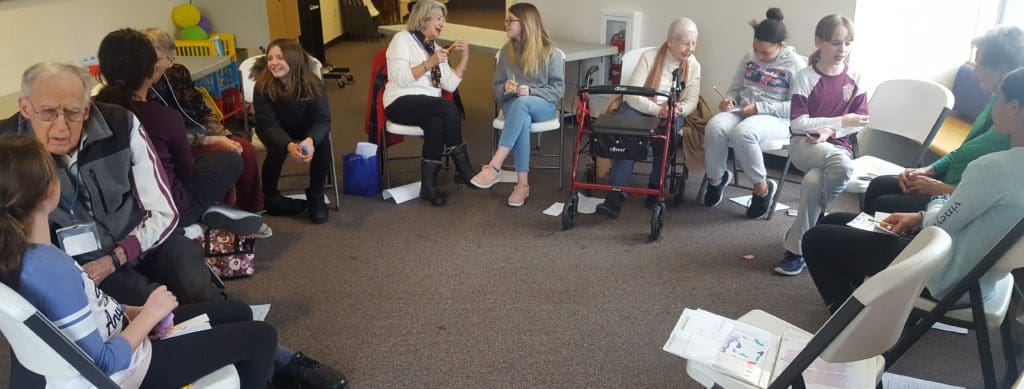New Learning Program Sparks Greater Empathy in Youth and Older Adults
At first listen, the chatter sounds much like a typical afternoon conversation in any sixth grade classroom in America. The discussions flow freely and it does not take long for the participants to find common ground. “Friendships are very important,” Gloria Stuhlmiller says to a student, who nods in agreement. “That’s what it’s all about.”
As Gloria goes on, it becomes clear that this is more than just your average exchange between middle school students. “Friendships change, and sometimes you lose them. They get sick, they move away. It isn’t always easy.”
The Harley School in Pittsford is not a typical grade school, which explains why Gloria and five of her fellow residents from St. John’s Meadows are circled up with seven sixth graders on this Tuesday afternoon in a second floor classroom. The six older adults are the second group to be invited to participate in W.I.S.E. (Working Together: Student/Senior Intergenerational Exchange), a program that started at the Harley School this past fall.

Harley is known for developing collaborative educational opportunities for students to make their community a better place; including the award-winning hospice course that nearly half of the school’s senior student population volunteers for each year. Sybil Prince—a psychiatric social worker who joined the school in January 2018—developed and implemented W.I.S.E. as a way to give younger students a meaningful experience collaborating with older adults, while progressively setting and meeting goals based on their weekly interactions. “The idea is to help them (the students) become more aware of what it is like to be an older adult and to feel more comfortable conversing with them,” says Prince, who also oversees the hospice class through Harley’s Center for Mindfulness and Empathy Education. Each 10-week trimester gives students a unique platform to interview older adults from St. John’s. The goal is to give students a platform to allow them to better relate to understand people from vastly different backgrounds.
As Prince was creating the curriculum for W.I.S.E., she envisioned St. John’s as the potential source for participants in their seventies, eighties, and nineties. Her previous role working as a geriatric care manager around the Rochester community brought her to St. John’s regularly, where she noticed a unique spirit of cooperation. Prince worked closely with another social worker—Chantel Foster—now resident life director at St. John’s Meadows. According to Foster, this new program was uniquely aligned with the type of intergenerational programing St. John’s was already offering. “Sybil had hoped to bring about a collaboration with a senior community to deepen mutual learning and understanding for the students,” says Foster. “I had been dreaming about new ways to partner with children in an intergenerational program.” Within a matter of weeks, the two social workers were planning for a fall launch.
When Don Hornburg looks back at his career, he separates his work history into three parts. After being pushed into an early retirement after working in the science and business fields, Hornburg spent 17 years as substitute teacher with the Hilton School District. “I enjoyed the teaching the most,” he says, referencing his ability to share his own personal stories and relate to students. “Kids like something different, and I was a different kind of teacher.”
As he takes the three mile bus ride to the Harley School every week, Hornburg finds that he is once again able to influence the learning experience of students in a positive way. “We’re at an age where we aren’t as able to get around and do things as much as we once were,” Horburg says. He enthusiastically participates in W.I.S.E. and believes the benefits of the program flow both ways. “I’m enjoying these kids. I really get a lot of out of this. And I think it’s really beneficial for them to interact with us older people. So many young people don’t have their grandparents around.”
W.I.S.E. fills a certain gap for the participating St. John’s residents as well. Several of these older adults report that their own grandchildren and great-grandchildren are often spread across the country, giving them less time to spend with them. This meaningful activity gives them the opportunity to interact with this next generation of school children and maybe even provides greater sense of purpose in their lives.
Prince cannot help but smile when she sees St. John’s residents walk through the school’s entryway. “I love the idea of bringing residents here—getting them out and having them come be a part of our school environment,” she says. However, she insists that St. John’s residents who travel to the Harley School every week are by no means passive contributors to a school project. “Everything the students do the elders do as well. They all help each other and learn from each other.”
To learn more about other unique St. John’s programs, check out”Programs that connect us.”
